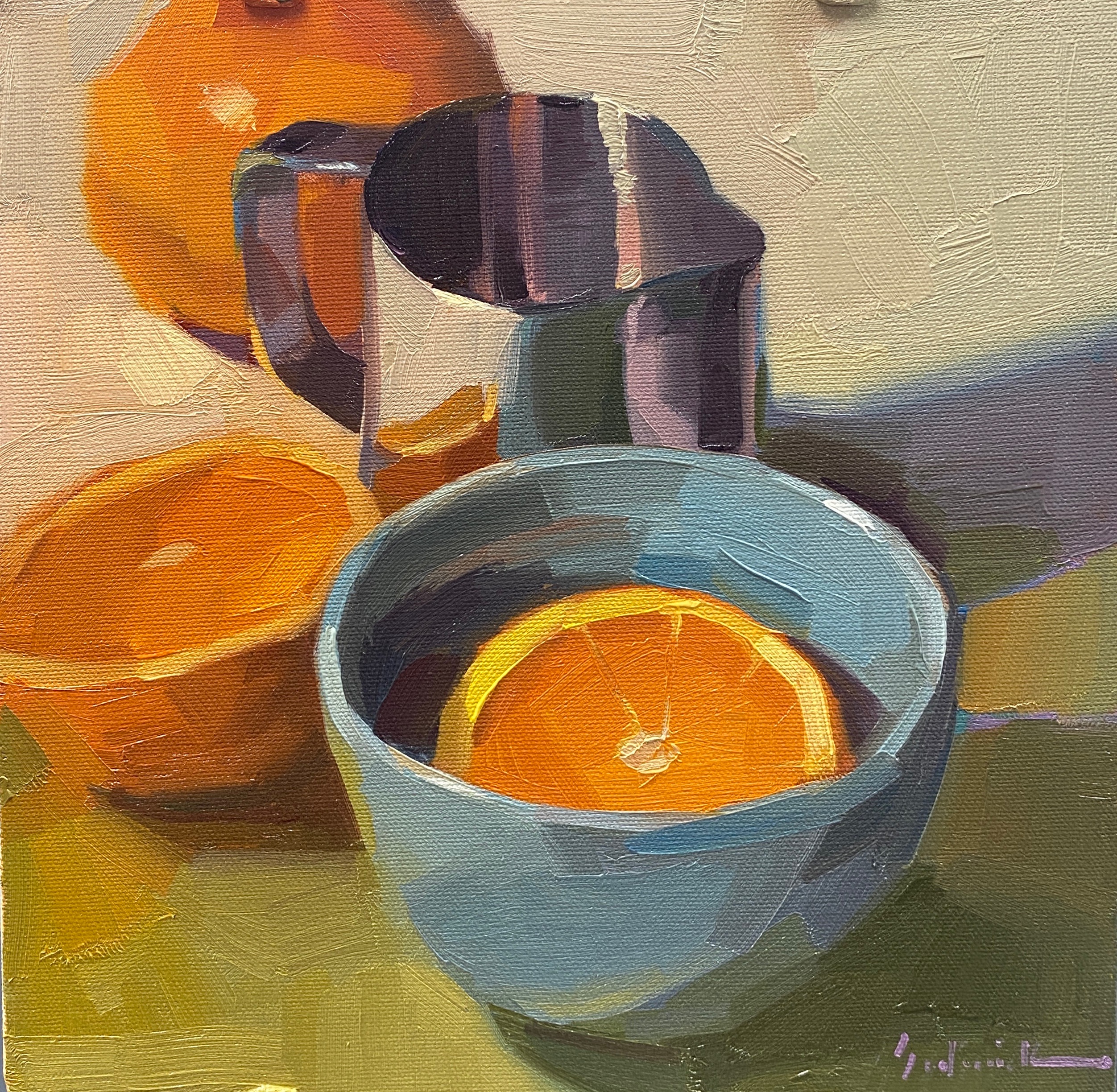Modern and Abstract Oil Paintings for Sale
Modern and Abstract Oil Paintings for Sale
Blog Article
Discovering All Concerning Oil Paints: An Overview to Recognizing Their Elegance and Worth
Oil paints have actually mesmerized audiences for centuries, providing a peek into the creative proficiency of numerous periods. Their rich history is linked with innovative strategies and extensive psychological expression. Comprehending the materials and approaches behind these art work can improve recognition. Additionally, the marketplace for oil paints offers possibilities for collection agencies and investors alike. As one discovers this fascinating globe, the concern develops: what makes an oil painting absolutely useful?
The History of Oil Paint: A Journey Via Time
Oil painting has origins that date back to ancient times, it absolutely grew during the Renaissance, when musicians discovered its versatility and abundant shade capacity. Early instances can be traced to the 7th century, with strategies progressing notably throughout societies. The tool became famous in Northern Europe in the 15th century, particularly with the jobs of artists like Jan van Eyck, who spearheaded its use for detailed realism and dynamic colors. This period noted a separation from tempera paints, permitting better deepness and texture. As oil paint spread, it affected countless musicians, leading to work of arts by renowned figures such as Leonardo da Vinci and Rembrandt. The medium's tradition proceeds, shaping the art world well into contemporary times.
Recognizing Oil Repaints: Products and Techniques
As artists discover the world of oil paints, they run into a varied selection of products and methods that define this medium. The main elements of oil paint consist of pigments, which give color, and drying out oils, such as linseed, that bind the pigments and help with application. Different ingredients can change the paint's appearance and drying time, enhancing convenience. Techniques like glazing, where transparent layers are developed, and impasto, which involves applying thick paint, enable various aesthetic results. Furthermore, the usage of brushes, scheme knives, and even fingers can create special appearances and surfaces. Understanding these techniques and materials makes it possible for musicians to completely reveal their imagination and achieve the wanted impact in their art work.
The Duty of Shade in Oil Paints
Color plays an essential function in oil paintings, affecting both aesthetic appeal and psychological vibration. Understanding shade theory basics, including the partnerships in between colors, can boost a musician's capability to convey state of mind and ambience. Furthermore, grasping color blending methods enables better depth and splendor in a painting's palette.

Shade Theory Basics
Recognizing shade theory is important for artists collaborating with oil paints, as it creates the foundation for creating unified and visually engaging structures. Color concept includes the research of just how shades engage, the color wheel, and the connections between main, second, and tertiary shades. Artists utilize complementary shades to enhance contrasts and develop prime focus, while comparable shades advertise unity and cohesiveness within an item. In addition, the principles of warm and awesome colors influence the perception of deepness and room in a painting. Comprehending these principles enables musicians to manipulate shade efficiently, leading the audience's eye and connecting their designated message. Proficiency of color concept ultimately enhances a musician's capacity to communicate feelings and ideas via their work.
Emotional Impact of Color
The psychological influence of color in oil paintings plays an important duty in how visitors view and attach with art work. Colors evoke details feelings and state of minds, affecting the audience's mood. For instance, warm tones like reds and oranges can develop a sense of heat and power, while awesome tones such as blues and eco-friendlies frequently stimulate peace or self-questioning. Artists strategically pick color combinations to boost narrative elements, assisting the target market's psychological journey. The saturation and comparison of shades even more intensify these results, drawing focus and developing emphasis. Eventually, the interaction of colors in oil paints not just boosts their visual allure yet likewise functions as an effective tool for psychological expression, improving the visitor's experience and interpretation.
Color Mixing Techniques
While lots of facets of oil paint add to the general structure, understanding shade blending strategies is vital for attaining wanted results and deepness. Shade blending can be come close to via numerous methods, consisting of the additive and subtractive processes. Additive blending includes integrating colors of light, while subtractive mixing relies on pigments, where colors mix to produce brand-new tones. Musicians commonly make use of a minimal scheme to develop unified works, comprehending the relationships between key, additional, and tertiary colors. Techniques such check here as glazing and scumbling further boost depth and luminance. By skillfully blending colors, an artist can stimulate feelings, develop focal factors, and attain a feeling of realism, inevitably boosting the painting's emotional and visual impact.
Famous Oil Painters and Their Iconic Functions

Famed for their proficiency of shade and strategy, oil painters have developed several of one of the most celebrated artworks in history. Popular artists like Vincent van Gogh mesmerized target markets with his stirring brushwork in "Starry Evening," while Claude Monet's "Perception, Daybreak" prepared for Impressionism. Leonardo da Vinci's "Mona Lisa" remains an enduring sign of creative brilliant, showcasing his skill in catching human expression. At the same time, Rembrandt's "The Evening Watch" highlights his cutting-edge usage of light and shadow. Other noteworthy figures consist of Pablo Picasso, that reinvented contemporary art with his strong testing in works like "Les Demoiselles d'Avignon," and Georgia O'Keeffe, whose dynamic depictions of flowers and landscapes helped define American innovation. Each musician's one-of-a-kind style added greatly to the oil paint landscape.
Just how to Examine the Quality of an Oil Paint
Reviewing the high quality of an oil painting entails a mindful evaluation of craftsmanship strategies, in addition to an analysis of color and make-up. Observing brushwork, layering, and the application of paint can disclose the artist's skill degree. In addition, the interaction of shades and the general plan of aspects contribute significantly to the painting's aesthetic worth.
Analyzing Workmanship Strategies
A thorough analysis of workmanship techniques is vital for figuring out the high quality of an oil painting. Critics need to initially analyze the application of paint; thick, textured brushstrokes might recommend a proficient hand, while overly consistent applications could suggest an absence of depth. oil paintings for sale. The layering strategy is also crucial; the existence of lusters and differed density can enhance luminance and complexity. Additionally, the top quality of the materials used, such as the canvas and pigments, plays a substantial function in resilience and general aesthetic. Attention to detail in elements like sides and shifts in between colors mirrors the musician's dedication to their craft. Eventually, these strategies add to the painting's psychological impact and market price, working as indications of the artist's ability and intent
Evaluating Color and Make-up
While assessing the high quality of an oil painting, one must concentrate on the interaction of color and make-up, as these aspects are fundamental to the art work's general impact. Color options can evoke feelings and develop mood; for that reason, the musician's combination ought to be checked out for harmony and contrast. A well-balanced structure guides the visitor's eye and develops a feeling of unity. Musicians usually employ techniques like the guideline of thirds or leading lines to improve visual rate of interest. In addition, using light and darkness can include deepness, boosting the three-dimensionality of the painting. Ultimately, a successful oil painting marries color and structure, engaging the customer and welcoming a much deeper admiration of the musician's vision and strategy.
Taking care of and Preserving Oil Paintings
Correct care and preservation of oil paints is crucial for maintaining their honesty and long life. To safeguard these artworks, it is important to display them away from straight sunshine, which can cause fading and discoloration. Keeping a stable environment with controlled temperature and humidity further help in avoiding damage. Cleansing ought to be done gently using a soft, dry cloth, preventing any kind of harsh chemicals that can hurt the paint or varnish. Regular examinations for indicators of damage, such as fracturing or flaking, are recommended. When transferring or saving oil paints, correct cushioning and framing are necessary to stay clear of physical injury. Inevitably, thorough treatment adds to the visual appeal and worth of oil paintings in time.
The Market for Oil Paints: Spending and gathering
Understanding the marketplace dynamics for oil paintings is essential for investors and enthusiasts alike. The value of these artworks is affected by various factors, consisting of the artist's reputation, historic importance, and existing patterns. Enthusiasts frequently seek items that reverberate personally while thinking about possible gratitude in worth. Galleries and auctions function as main locations for purchasing and marketing, with rates varying based on need and rarity. Buying oil paints needs study into the marketplace, as well as an understanding of credibility and provenance. In addition, arising artists might use possibilities for significant returns, while developed names can regulate high prices. In general, a tactical approach to accumulating can generate both visual pleasure and economic incentives.

Often Asked Concerns
What Are the Ecological Impacts of Oil Painting Materials?
The ecological influences of oil paint materials include the release of unstable natural substances (VOCs), hazardous waste generation, and resource extraction for pigments. These factors add to contamination and environmental destruction, elevating problems among environmentally conscious artists and consumers.
How Do Different Canvases Affect Oil Painting Results?
Different canvases affect oil paint results significantly. Surface, structure, and absorbency high quality can modify paint application, drying times, and shade vibrancy. Artists commonly choose particular canvases to attain desired effects and improve their imaginative expression.
Can Oil Paintings Be Restored if Harmed?
Oil paints can indeed be brought back if harmed. Professional conservators use different strategies to fix tears, clean surfaces, and address staining, making sure that the art work retains its initial beauty and worth for future generations.
What Are the Signs of an Original Oil Painting?
The signs of an original oil paint include visible brush strokes, texture variations, and an unequal canvas weave (oil paintings for sale). Furthermore, authenticity might be verified through provenance, trademarks, and the presence of a varnish layer one-of-a-kind to oil tools
Exactly How Has Technology Influenced Modern Oil Paint Techniques?
Innovation has actually substantially influenced modern-day oil paint methods by introducing digital tools for planning, boosted materials for appearance and longevity, and on-line platforms for sharing and selling art, therefore increasing musicians' creative possibilities and target market get to. Oil paint has roots that date back to ancient times, it truly prospered throughout the Renaissance, when musicians uncovered its adaptability and rich shade potential. The psychological effect of shade in oil paintings plays a critical role in how viewers perceive and attach with artwork. While lots of facets of oil painting contribute to the overall make-up, understanding color blending techniques is essential for attaining preferred effects and deepness. Reviewing the high quality of an oil painting entails a cautious analysis of workmanship techniques, as well as an evaluation of color and make-up. While examining the quality of an oil painting, one must focus on the interplay of color and structure, as these aspects are basic to the art work's total influence.
Report this page